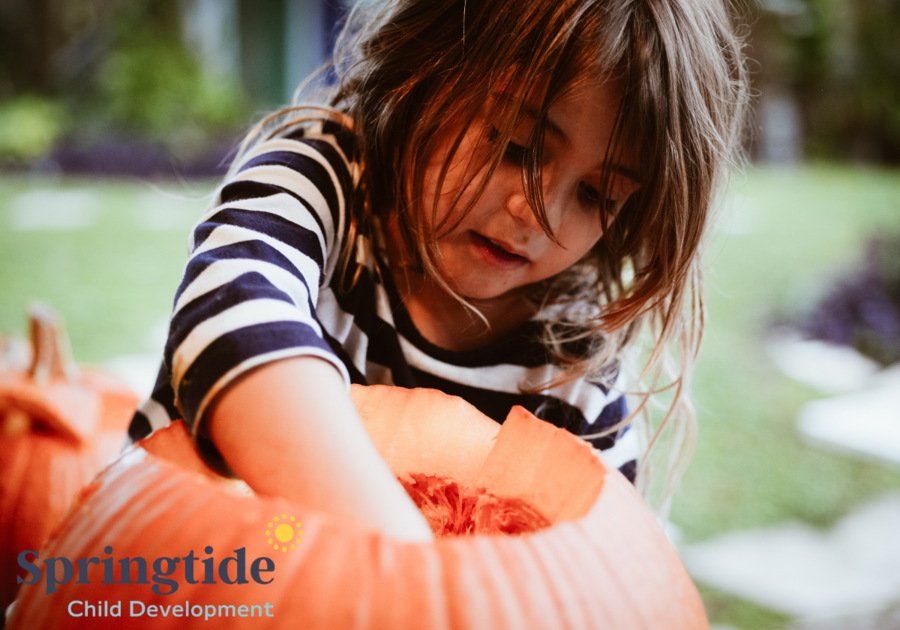Halloween is a holiday that most adults see as a “kids” holiday. Dressing up, trying to scare one another, running house to house in the dark to get free candy, and wearing silly costumes. However for parents of children with sensory disorders, this holiday can be fraught with worry about each of these holiday traditions. Below are ideas on how parents can make Halloween as sensory successful as possible.
Sensory Friendly Pumpkin Scooping
What you’ll need -
- Pumpkin with the top carved off
- Bowl for the gooey seeds
- Large bowl filled with water for easy hand rinsing
- Spoons, scoops, clothespins, and tongs
- Paint and paint brushes
Reaching into a pumpkin can be filled with all sorts of sensory surprises!
We recommend having a bowl of water ready for a quick and easy rinse off; if feeling the pumpkins insides gets to be too much! And if that feeling is just unbearable we recommend using spoons or “scoops” (measuring cups) to continue scooping out the pumpkin!
To strengthen fine motor skills try using tongs or clothespins as a fun way to grab the pumpkin seeds and turn it into a fun counting game! Who can get the most pumpkin seeds in their bowl? Who has the most gooeyness in their bowl?
If your child is overly sensitive to the smell or texture in general, you can also paint pumpkins or decorate them with stickers!
Making the Most Out of Costumes!
What you’ll need:
- Costume
- Scissors
- Stick-On Velcro
Dressing up can be fun - it can also be sensory OVERLOAD! With a little prep work you can be prepared for either option!
Costume Selection Tips:
Make sure to remove the tags and check for anything “scratchy” or “tight”
Loose is best! (easy on, easy off, and easy to layer!) Stick on velcro can help with this.
Do a sample “play day” in the costume to be sure your child is comfortable and ready for the day!
During the Event:
Have an extra outfit on hand in case it’s just too much - and remind yourself that IT IS OK!
Don’t force your child to wear an outfit they’re uncomfortable in - perhaps opt for a hat, a headband, or a sticker!
If they make it through the evening in their costume let them know how much fun you’re having with them! If they let you know they need to change; let them know how proud you are of them for telling you what they need for their bodies to feel comfortable!
Spooky Story Time
What you’ll need -
- Halloween Books : Room on the Broom, Click Clack BOO, Go Away Big Green Monster
- Blanket and Pillows
We love a fun story time - and even better a “spooky” story time! Find a comfy corner and bring over blankets and pillows so it’s comfy, cozy for story time. While reading, invite your child to act out what is happening in the stories or jump whenever they hear BOO! Your child will remember this simple tradition for years to come and will allow you a moment to bond over this spooky season!
Sensory Friendly Trick-or-Treating
Trick-or-treating is the main event of most kids' Halloween experience, but can be overwhelming and confusing to those with sensory processing difficulties. Having story times, social narratives, visuals, or fun videos of sounds they might hear, what they will be doing, and possible flashing lights or decorations will help prepare them.
During the event, going while it is still light out can help reduce anxiety as well as mainly staying on the quiet streets.
Role playing the sequencing of events when trick-or-treating can be helpful in reducing anxiety as well. Practice going up to your door, saying “trick-or-treat,” and receiving and thanking them for the treat.
To be extra prepared, have a code word between your child and who is trick-or-treating with them that can be used in case they begin to feel overwhelmed. Reassure them that it’s okay to use the code word.
Author: Springtide Child Development, Taylor Lauder, Master's Degree in Occupational Therapy & Amanda Woodman, BCBA



